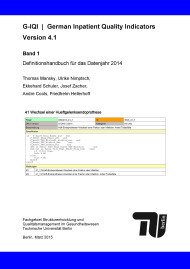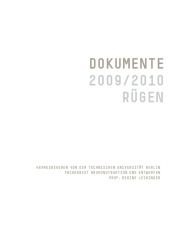G-IQI – German Inpatient Quality Indicators. Version 4.1 – Volume 1
Definitionshandbuch für das Datenjahr 2014

Publishing year: 2015
The German Inpatient Quality Indicators (G-IQI) have been developed for measuring quality and volume indicators for specified diseases and/or procedures based on administrative data. In Germany the administrative billing data of the hospitals (the so called DRG-data) are electronically exchanged with the insurance companies and also once a year delivered to the federal office of statistics via standardized data interfaces (specifications according to § 21 KHEntgG and § 201 SGB V). G-IQI provide medically meaningful information about important and/or frequent diseases and procedures, which are treated or performed respectively in the German hospitals. Wherever possible and medically sensible information concerning outcome is provided besides volume indicators. In many cases this is the in-hospital mortality for the specific disease or procedure. This volume presents the revised G-IQI version 4.1. Besides modifications and clarifications refering to many details of the last version new indicators for additional disease and procedure groups have been defined. These refer to many diseases, where the public or the potential patient looking for a hospital would like to get at least information about the experience, which a hospital has in treating this disease. This would for example be the case for the treatment of epilepsy in children or adults or for the treatment of brain tumors. For other areas the previous structure of G-IQI has been revised and the subgroups have been segmented in a different way (for example in case of hip and knee replacement or spinal surgery). The new G-IQI version 4.1 covers 44.9% of all in-patient cases in Germany according to the German DRG data 2013. This is more than in other disease specific indicator systems. The in-hospital mortality indicators cover 55.7% of all in-hospital deaths. The technical specification of the indicators given in this volume is augmented by a complete analysis of all German inpatient episodes 2013 using the G-IQI indicators (18 million cases). Thus for every indicator the national volume and the respective reference value is given in this publication. For many diseases and procedures covered by G-IQI this is a unique reference. Furthermore hospitals using G-IQI can use these values to compare themselves to the national average. Indicator systems like G-IQI can be used for public reporting. In this way G-IQI is used by the ‘Initiative Qualitätsmedizin’, an association of currently 330 German hospitals publishing their results based on these indicators. Furthermore the Swiss Bundesamt für Gesundheit uses a Swiss variant of these indicators (CH-IQI) for an obligatory public reporting for all Swiss hospitals. Predominantly, however, G-IQI indicators are used within the internal quality management of the hospitals for further improving their outcome. Results which deviate from the federal average may and should be a reason for investigating the treatment processes of the respective disease, which may for example involve peer reviews of medical records. Using the indicators as a trigger tool it is possible to install an efficient and highly effective outcome oriented quality management within a hospital. The methods used for this purpose have been described in other publications.



